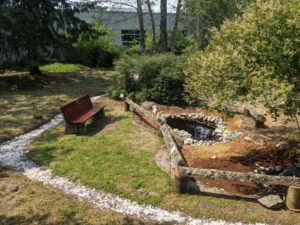Two Environmental Technology students have used the knowledge gained from their courses to give back to Camosun. Christina Chen and Roxanne Cameron used their sustainability Capstone project to revitalize the Native Plant Garden on Lansdowne campus and turn it into what is now Camas Hill.
Camas Hill, located beside the Wilna Thomas Building, is named after a purple flower found—along with many other wildlife species—in the garden. And it’s now a peaceful place for students to escape from campus and educate themselves on native and invasive plant species.
“We took a plants course; we focused on mosses for one portion of it, and with that, we looked at the fence, which was previously in that area, and we were really interested in learning more about them,” says Chen. “And it was also a thing that the fence was going to be taken down.”

The Native Plant Garden has a long history at Camosun. It was first established at the end of the 1970s and was situated where the Lansdowne Library is currently located.
“The idea of the Native Plant Garden was to be an educational area for students in the Bio department,” says Cameron. “I think the idea started back in 1979, and during the ’80s, it was situated in the current location that the library is located, but in that time, the college received funding for the new library… and the person in charge of [the garden] functioning requested that they find a different location for the library but I guess they got shut down, so they had to move the garden. So, where it was moved is where it is now.”
Chen and Cameron didn’t want to tear down what was left behind in the garden even though it had been neglected for several years. They utilized what was already present, like an old bench and fence, and also put a Camosun employee’s side hobby to use.
“We decided to take the area and make it more welcoming and appealing,” says Cameron. “The old bench had been overgrown and faded with mosses, so we sanded that down and stained it. The old area that was previously a pond, we cleaned out the muck and debris from it and repaired the pond liner, and established it into a moss bog. There’s a gentleman who works for Camosun Facilities who has a side hobby of growing little miniature bog-style ecosystems, so he had an idea last spring that I caught wind of. I reached out to him to see if he was still interested, and he provided us with the plants and design, and then we did the physical work and labour to build it.”
While they want to restore the plant garden to its former glory, Chen mentions that she hopes it will also shed some light on their underfunded program.
“It also provides the opportunity to show people—well, the college—how important environmental technology and the program is,” says Chen. “We are kind of underfunded and underrecognized.”
Chen and Cameron hope that Camas Hill will help students become more aware of the surrounding ecosystems.
“I wanted to do this project because I feel the area has a lot of potential, on an environmental level, and on an educational level, too,” says Cameron. “We just wanted everyone to realize there was an additional area they could hang out and enjoy a little getaway from the campus itself. And they can take the time to learn about some of the species that live there, because the area has, unfortunately, been invaded by a lot of invasive species. But it’s an opportunity to learn the difference between our native and invasive species.”
